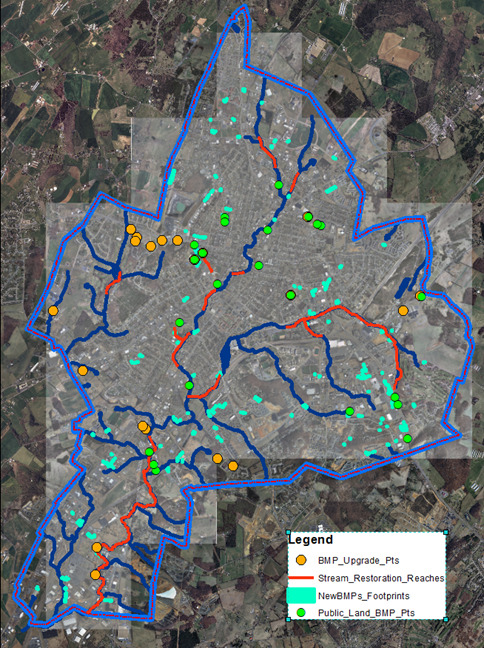Harrisonburg Citywide SWIP
Harrisonburg, VA
AMT provided a comprehensive and citywide stormwater improvement plan (SWIP) for Chesapeake Bay TMDL compliance with phosphorus, nitrogen, and sediment load reductions as required for the MS4 regulated area, by way of Black’s Run, the Shenandoah River, and the Potomac River downstream.
The Phase One Study included a city-wide watershed assessment and literature review of previous studies, system-wide capacity assessment of 154 drainage and flooding issues, water quality assessment of structural and non-structural BMP crediting towards the city MS4 goals, a citywide program assessment of policies and opportunities to achieve TMDL compliance, and a determination of future regulatory changes necessary to implement the MS4 program.
Once program goals were determined and non-structural BMP crediting was established in the TMDL action plan for Phase One, AMT’s team began the evaluation of Best Management Practices (BMP’s) using a GIS desktop analysis and the EPA SUSTAIN model with site criteria statements overlaid on geodatabases. AMT conducted field investigations of the best identified BMP sites for overall feasibility, developed a prioritization and ranking tool for selected BMPs (Excel workbook), and developed budgetary estimates of program costs. Structural BMP’s in the TMDL action plan include nearly 6-miles of impaired stream reaches, 20+ BMP retrofits and 120+ New BMP’s including wet ponds, vegetative filter strips, shallow marshes, enhanced extended detention basins, bioretention, and a regenerative stormwater conveyance (RSC) channel.
Since the City had already achieved 2018 goals in the MS4 general permit, through non-structural BMPs, the SWIP report prioritized BMPs for 2023 and 2028 goals primarily. High Priority Concept Plans were developed for projects at Eastern Mennonite University, James Wood Middle School, Westover Park and elsewhere. Each concept plan included site evaluations, GIS mapping, pollutant removal calculations and budgetary estimates. In each phase of this TMDL study, presentations were made to the Stormwater Advisory Committee (SWAC) with AMT working as an extension of City staff, followed by two citywide public meetings with good attendance.


